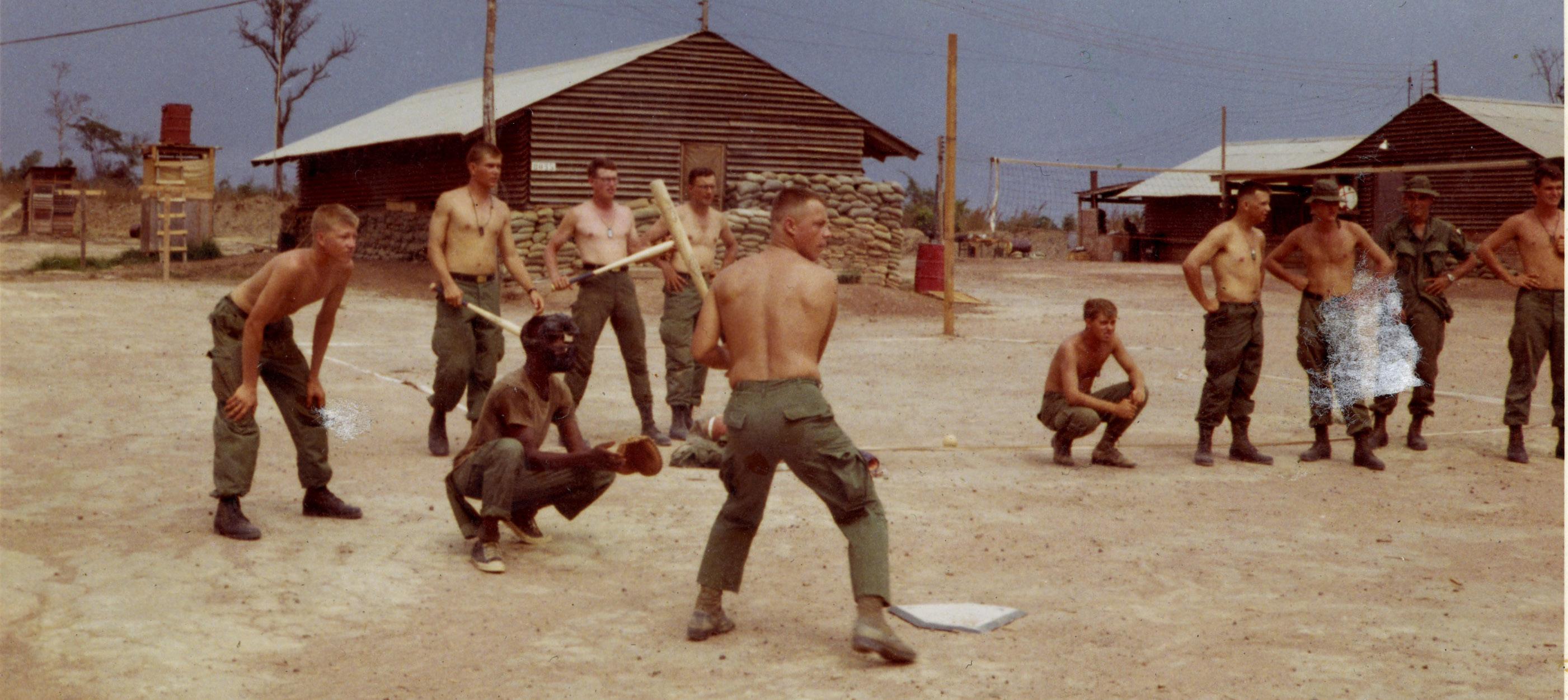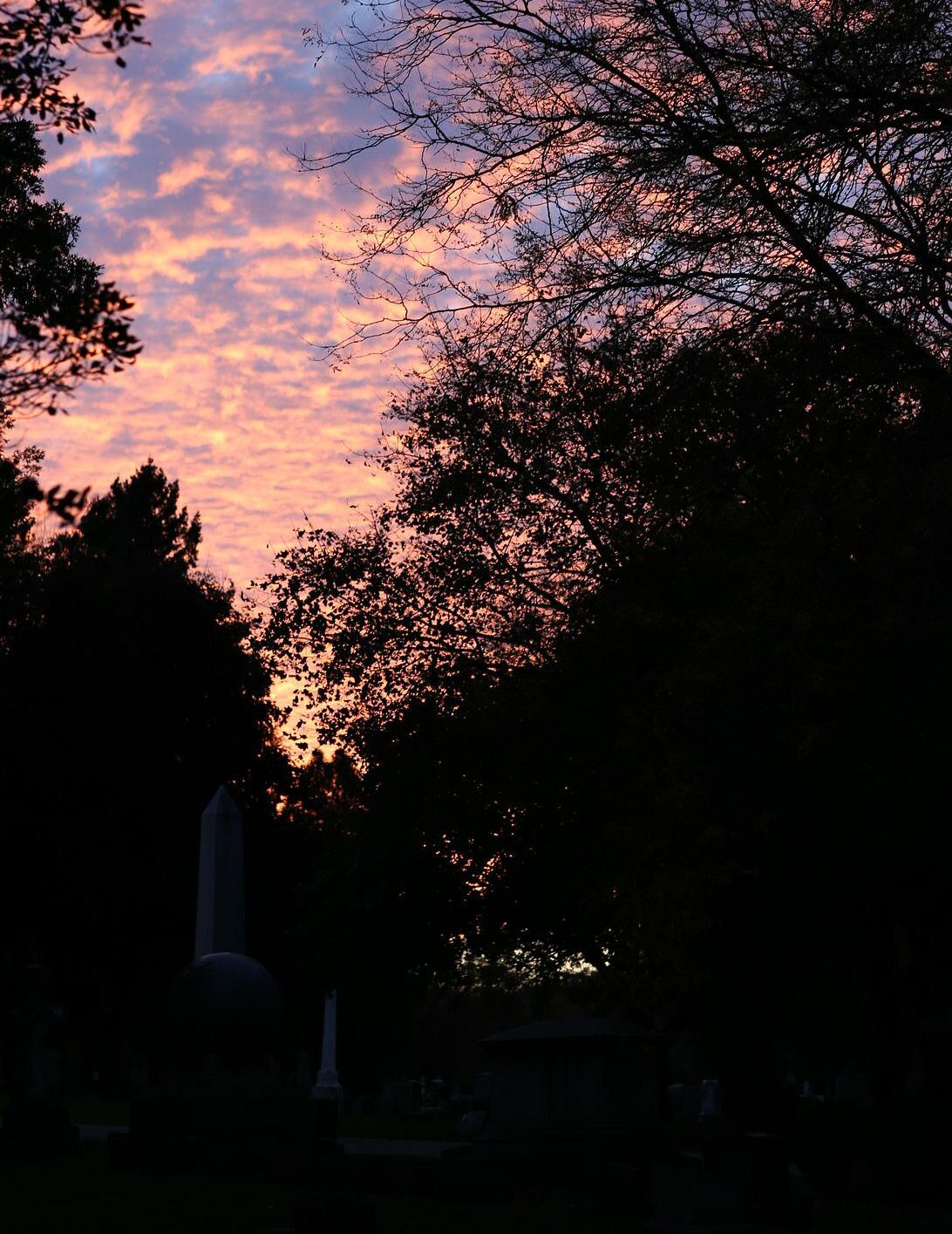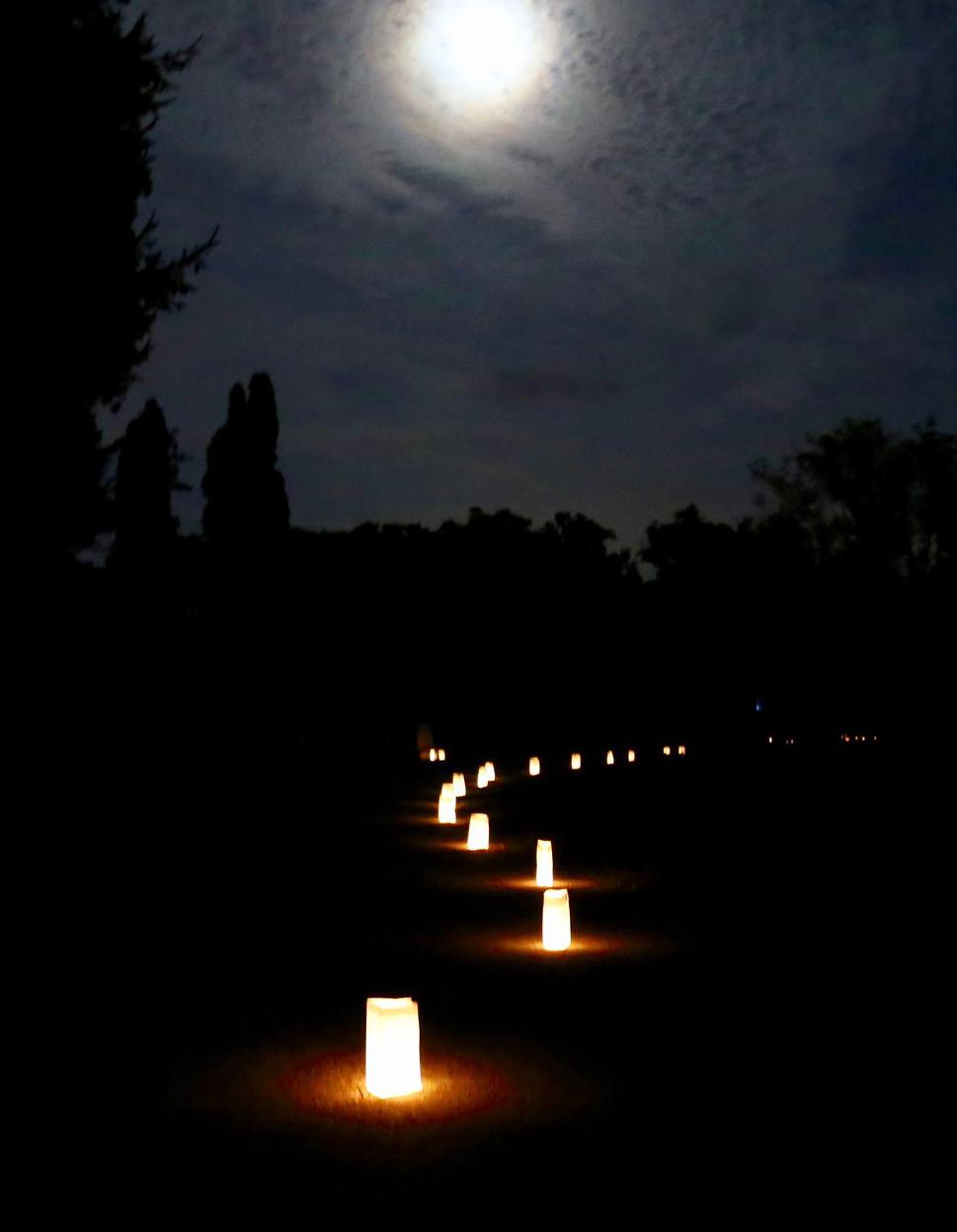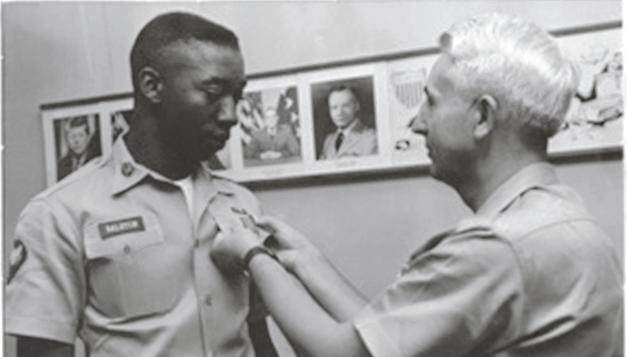BU G LE THE

SUMMER 2019 | VOLUME 26:2

3 7 | EDITOR'S NOTES 8 | FROM THE COLLECTIONS 10 | FROM THE ARCHIVES 12 | CEMETERY TOURS 14 | COVER STORY 20 | FROM THE ARCHIVES 22 | EVERY VETERAN IS A STORY 26 | CALENDAR 28 | FROM THE FOUNDATION 30 | VOLUNTEER SPOTLIGHT 31 | ACKNOWLEDGEMENTS CONTENTS
Chief Photographer's Mate Robert F. Sargent, United States Coast Guard (USCG), took this shot of 1st Infantry Division troops disembarking from a Coast Guard-manned landing craft, vehicle, personnel (LCVP) on the morning of June 6, 1944, at Omaha Beach. (National Archives)
MUSEUM STAFF
ASSISTANT DIRECTOR
JENNIFER VAN HAAFTEN 608.261.6802
OPERATIONS ASSISTANT
ELISE MCFARLANE 608.261.0534
ORAL HISTORIAN
LUKE SPRAGUE 608.261.0537
SENIOR MARKETING SPECIALIST




KAREN BURCH 608.264.6086
CURATOR OF HISTORY
KEVIN HAMPTON 608.261.5409
PROCESSING ARCHIVIST

BRITTANY STROBEL 608.800.6958
COLLECTIONS MANAGER
ANDREA HOFFMAN 608.800.6957
REFERENCE ARCHIVIST
RUSS HORTON 608.267.1790
REGISTRAR
SARAH KAPELLUSCH 608.800.6955
CURATOR OF EXHIBITS
GREGORY KRUEGER 608.261.0541
STORE MANAGER
GREG LAWSON 608.261.0535
ART EXHIBIT COORDINATOR


YVETTE PINO 608.266.1854
EDUCATION SPECIALIST
ERIK WRIGHT 608.264.7663
COMMENTS & SUBMISSIONS

We welcome your comments and editorial submissions concerning The Bugle. Comments and submissions should be sent to Karen Burch at Karen.Burch@dva.wisconsin.gov
PRESIDENT
DAN CHECKI
VICE PRESIDENT
JOANE MATTHEWS
TREASURER
DAN
FOUNDATION
THE WISCONSIN
4 5
VETERANS MUSEUM
SECRETARY TOM
BOARD OF DIRECTORS DIRECTORS
HEILIGER
HUISMANN FOUNDATION
AT LARGE DAN GREENE
JASON JOHNS
WILLIAM F. HUSTAD
TIMOTHY LA SAGE
EXECUTIVE
JENNIFER
JENNIFER.CARLSON@WVMFOUNDATION.COM 608.261.0536
608.261.0536
JOSEPH NAYLOR PHIL PRANGE BOB SIMMONS
DIRECTOR
CARLSON
DONATE@WVMFOUNDATION.COM
STAFF
BUGLE is published quarterly for our members and friends through the support of the Wisconsin Veterans Museum Foundation. The Wisconsin Veterans Museum Foundation provides funds for the support of artifact acquisitions, exhibit production, and the development of educational programs Join Us Online! COLLECTION DONORS 3/1/19–5/31/19 Eva Bellinger Christine Cross Mary Eagan James C. Ellestad David Gess Robert Miller Eric Oxendorf Patti Pattison Lanny Smith Juniper Sundance Robert Zuleger A most sincere thank you to all who donated to our collection from March 2019–May 2019. Thank you for your generosity and support of The Wisconsin Veterans Museum. 30 WEST MIFFLIN STREET MADISON, WI 53703 ON THE CAPITOL SQUARE 608.267.1799 www.wisvetsmuseum.com MUSEUM HOURS Closed Mondays Tuesday−Saturday 9:00 AM–4:30 PM Sunday (April-September) Noon–4:00 PM RESEARCH CENTER HOURS By appointment only Tuesday-Friday 9:00 AM–3:30 PM MUSEUM MISSION The mission of the Wisconsin Veterans Museum is to commemorate, acknowledge, and affirm the role of Wisconsin veterans in America’s military past and present
THE
Editor's Notes

Among the five armed services, the Coast Guard may be the least understood by the average American. Its varied mission includes an array of responsibilities ranging from homeland defense, maritime law enforcement, search and rescue, aids to navigation maintenance, Immigration and Customs Enforcement (ICE) operations, and military readiness. Unlike any other branch of the armed forces, the Coast Guard has jurisdiction to enforce maritime laws in both domestic and international waters. However, its military role is perhaps the least understood aspect of its mission. For many Americans, it comes as a surprise to learn that the Coast Guard has participated in every major American conflict since the beginning of the Republic. Operating as a specialized service under Navy command, the Coast Guard offers expertise in small boat seamanship, an asset that allowed it to play a major role in the amphibious landings in both the European and Pacific theaters during World War II.
In this issue, we will take a brief look at the Coast Guard’s activities during World War II, and the critical responsibilities it had in those landings, as well as its pioneering efforts in desegregating our nation’s naval services. It’s a fascinating story that is often overlooked.
By the time this issue reaches your mailbox, we will have already observed the 75th anniversary of D-Day with an exhibition of material owned by Martin Gutekunst. It seems inconceivable that three-quarters of a century have passed since the invasion of Europe in June 1944. But time marches on, and that’s why our mission to preserve the memories of Wisconsin veterans is so important. The shared experiences of our veterans serve as an example of unity and sacrifice in the defense of freedom and national values. Veterans come from all walks of life and are a microcosm of our nation. Getting to see a part of ourselves in each of them helps bind us together as a nation and a chance to appreciate the sacrifices each service member made.
Heading into the summer months, we urge you to take a look at our website for public program updates and other activities that we offer. In addition, we are adding a new traveling exhibit, I Am Not Invisible, featuring Wisconsin women veterans and selections of their own words about their service. Please watch our website event page for details on our inaugural exhibition. After that, it will be traveling around the state. You can book a showing in your area by heading to our webpage at:
www.wisvetsMuseum.com/exhibits/traveling-exhibits/

As always, thank you for your continued support of our exhibits and programs.

7 7
Charles Post Collection, WVM.0529.I002e.01
COLLECTIONS FROM THE
In the spring of 1919—long after many fellow Wisconsin veterans had already made their way back to the Badger state—University of Wisconsin botany professor George S. Bryan remained on duty in postWorld War I Germany. Bryan had recently transferred from the 85th Division to the 139th Infantry Regiment and was reassigned to the position of commandant of Camp Quedlinburg, a Prisoner of War (POW) camp in central Germany. Even though the Germans held French, English, Belgian and Italian soldiers there during the war, by the time Bryan arrived Camp Quedlinburg consisted largely of Russian prisoners. The grounds were in dismal condition in every regard, leaving Bryan with a monumental task on several levels.
As part of his recently-donated collection, Bryan’s diaries from the period shed light on his early initiatives to improve conditions for the prisoners, including instituting regular schedules for bathing, latrine scrubbing, changing bed linens, and issuing clean clothing. Bryan simultaneously worked to fix an inadequate prison record keeping system as well as improve the camp’s facilities, prioritizing repair of the electrical lights amongst other structural issues. He also noted uneasiness between the German guards and restless Russian prisoners, several times

mentioning “discontent and grumbling” amongst those in the camp. Bryan promptly addressed this issue, too, by requesting better rations for the prisoners, whose former meagerness he believed at least partially responsible for the unrest. While Bryan’s primary responsibilities revolved around improving the physical conditions of the camp, his desire to improve prisoner morale was at the forefront of his efforts. Just weeks after arriving, he mentioned the importance of adding “a theater, gardens, schools, and athletics” to the


camp. He requested teachers be brought to the camp in addition to organizers for sporting events and theatrical performances to help further break up the monotony of daily life for the prisoners. The combination of these efforts appeared to do more than merely help suppress the discontent of the over 4,000 men at Quedlinburg; they endeared them to their commandant. Also found in Bryan’s collection are gifts made for him by the Russian prisoners, including a bust modeled of him in uniform and a signed photograph of the camp’s Ukrainian theater troupe.
Bryan wrapped up his tenure at Quedlinburg at the end of the summer and was honorably discharged on September 23, 1919. He returned to Madison and went on to become a renowned professor in his field, later traveling to exotic locales like Peru and Tanzania for his research and co-authoring a significant text book on botany. But little did Bryan know when he left the camp that some of the prisoners he left behind would still be there two years later, until the camp was finally closed in 1921 and burned to the ground to mark its end. Bryan’s impressive collection of camp records, diaries, photographs and souvenirs provide important insight into the difficulties of his position in a period of transition at the end of the war, and ultimately demonstrate the reward of his humanitarian efforts.
By: Andrea Hoffman
Collections Manager
Studio portrait of George S. Bryan, taken in Madison shortly after receiving his commission as a Captain in the U.S. Army, August 1917. (Mss2019.012.001)
Bust and sculpture of George S. Bryan made for him by a Russian prisoner held at Camp Quedlinburg, Germany. (V2019.012.1),(V2019.012.2)
A detailed sketch of the Camp Quedlinburg grounds drawn by George S. Bryan (Mss2019.012.001)
Photograph taken of the “Ukrainian Theater Party” at Camp Quedlinburg on August 13, 1919. The back is captioned in Russian, and translates in part to “For Good Remembrance, to Major Bryan…for help of Russian Prisoners of War.” (Mss2019.012.001)
8 9
Just weeks after arriving, he mentioned the importance of adding “a theater, gardens, schools, and athletics” to the camp.
ARCHIVES


 (Above) Marine Corps Lady Leathernecks Baseball Team stationed in Hawaii during World War II.
From the collection of Roberta Wells, WVM Mss 1776
(Left) Soldiers from the 187th Infantry Regiment, 101st Airborne Division, playing baseball in Vietnam.
From the collection of Delbert Hunt, WVM.1649
(Above) Marine Corps Lady Leathernecks Baseball Team stationed in Hawaii during World War II.
From the collection of Roberta Wells, WVM Mss 1776
(Left) Soldiers from the 187th Infantry Regiment, 101st Airborne Division, playing baseball in Vietnam.
From the collection of Delbert Hunt, WVM.1649
10 WWW.WISVETSMUSEUM.COM 11
TALKING SPIRITS CEMETERY TOURS


During the week of September 30th–October 6th, the Wisconsin Veterans Museum will host its 21st annual Talking Spirits Cemetery Tour, held at the beautiful Forest Hill Cemetery in Madison. On this ninety-minute walking tour, local actors will portray important Civil War-era figures buried at Forest Hill. This year’s theme will be Service Beyond the War and will feature four vignettes which highlight the contributions made to Madison by some of its most prominent members during the community’s antebellum period.
Cast of Characters
Benjamin Butts

As a runaway slave, Bennie Butts became attached to the 5th Wisconsin Battery during the Civil War and followed the unit back to Wisconsin after the war ended. He eventually moved to Madison, where he became a barber on Capitol Square to many Governors, as well as a messenger at the Wisconsin Historical Society and a prominent member of Madison. His son, Leo, was the first African-American to play football for the University of Wisconsin.

William F. Vilas
One of Madison’s most revered citizens, William F. Vilas served as a regent of the University of Wisconsin–Madison from 1880 to 1885 and 1898 to 1905. He also served as a member of the Wisconsin State Assembly in 1885, until he was appointed the Postmaster General between 1885 and 1888, and as Secretary of the Interior from 1888 to 1889, both under President Grover Cleveland.

Napoleon Bonaparte Van Slyke
Assistant Quarter Master General of Wisconsin during the Civil War, Napoleon Van Slyke went on to become an influential member of the community through his involvement in the Wisconsin Historical Society, the University of Wisconsin–Madison, and the Wisconsin State Bankers Association.
Cordelia Harvey
Wife of the late Governor Louis Harvey, Cordelia Harvey not only advocated for the care of Wisconsin soldiers during the Civil War, but also created a home in Madison to care for those orphaned by the ravages of the conflict.

12 13
ALWAYS READY The Coast Guard in World War II

Since 1790, the Coast Guard has been involved in every major United States conflict. Under the overall command of the Navy in time of war, the Revenue-Marine (renamed the Coast Guard in 1915) recorded the first capture of a British Navy ship in the War of 1812, and the Revenue Cutter Harriet Lane is generally credited with firing the first naval shot of the Civil War. During World War I, Coast Guard vessels again under Navy command, plied the Atlantic while engaged in anti-submarine warfare. But it was in World War II where the seamanship skills of Coast Guard officers and men played a significant part in the ultimate victories in Europe and in the Pacific theaters.
 Cover Story By: Michael Telzrow
Cover Story By: Michael Telzrow
14 15 15
Coast Guard Cutter Spencer (WPG-36) served in both the Atlantic and the Pacific Theaters. She is credited with the sinking of the German submarine U-175. (National Archives)
During World War II the Coast Guard provided officers and crew to manage more than 350 naval ships. Eight hundred formerly white Coast Guard cutters of various configurations were painted gray and transferred into Navy service. While they may have lost their Coast Guard white, they retained their identity in every other respect.

Coast Guard-manned vessels included the aforementioned cutters as well as transport ships, cargo and attack-cargo ships, LST's (Landing Ship, Tank), and frigates. Some Coast Guardsmen like Wisconsin’s Charles Walther even served aboard Army ships with all-Coast Guard crews. Just as important as the transport and amphibious craft were the sixty 83-foot cutters of Rescue Flotilla One that pulled hundreds of men from the sea at D-Day.
It was in the thousands of amphibious-type assault craft where the Coast Guard played its most unique role. It was the Coast Guard who put many of the soldiers and Marines on the beaches of North Africa, Sicily, Italy, France, and the Pacific Islands, often under tremendously difficult situations. These operations, carried out from Coast Guard-manned offshore transports and Navy vessels, depended upon the skills of seasoned coxswains and seamen. Experience gained from handling treacherous surf and dangerous sandbars and reefs while in the service of life-saving made Coast Guard coxswains the most capable seamen available. The average Navy coxswain was simply not as skilled as his experienced Coast Guard counterpart, and many of the former were trained by the latter in the fine points of managing a small boat in heavy surf. It is telling that the Coast Guard’s only Medal of Honor recipient, Signalman First Class Douglas Munro, gave his life while assisting a grounded LCT (Landing Craft, Tank) after extracting Marines from a contested beach at Guadalcanal. The Coast Guard’s role in our nation’s conflicts has often been overlooked. Perhaps it is because the service came under the control of the Navy during wartime, or perhaps it is because its strong association with life-saving stands in stark contrast to its military role. Whatever the reason, its contribution to our nation’s military efforts is due for appropriate recognition. Today, the Coast Guard continues its tradition of military readiness and is a major asset in the Homeland Defense arsenal. Semper Paratus!
Seaman’s Knife (Previous Page)
CLIFFORD LEWIS of Waupaca, Wisconsin obtained this seaman’s knife while training in Dartmouth, England. Lewis served aboard LCI(L-94) as part of Flotilla 10 and participated in amphibious assaults at Sicily, Salerno, Normandy, and in the Pacific Theater. (V2014.015.3)
African American Coast Guardsman (Left, Top & Middle)
In late 1943, the Coast Guard-manned USS Sea Cloud (IX-99) became the nation’s first naval vessel to fully desegregate. The Navy would follow suit one year later. (National Archives)

Wounded Coxswain (Left, Bottom)
Wounded by enemy fire, a Coast Guard coxswain is removed from his landing craft on D-Day.(National Archives)

Denim Jacket (Right)
CHARLES WALTHER of Mineral Point wore this shawl-collar denim utility jacket during WWII. Walther, an electrician’s mate, served aboard a sea-going tug in the Pacific. (V2002.41.5)



16 17




Store.WisVetsMuseum.com Now through September 23rd
ARCHIVES
 Shipboard boxing match aboard USS Arkansas during World War I. Photograph by Navy Electrician 1st Class Emil Trushinske, a Waukesha resident.
Shipboard boxing match aboard USS Arkansas during World War I. Photograph by Navy Electrician 1st Class Emil Trushinske, a Waukesha resident.
20 21
From the Emil C. Trushinske collection, WVM Mss 2203.
Elizabeth N. Johnson

Wisconsin native, joined the Army Nurse Corps in 1934 and trained Army nurses during World War II. She deployed to Korea with the 8076th Hospital (MASH) in July 1950, working to heal and help soldiers wounded while fighting in the Korean War. Johnson retired from the Army in 1954 after twenty years of service. WVM proudly preserves her story through the letters she wrote home from Korea and a scrapbook filled with photographs from her service.

22 WWW.WISVETSMUSEUM.COM 23
IS A STORY
EVERY VETERANIS A STORY
EVERY VETERAN
John Cadman, a Stevens Point, Wisconsin native, volunteered for service with Company I, 4th Wisconsin Infantry Regiment during the Spanish-American War. Deemed too light for service as an infantryman, he was allowed to serve as a bugler for the regiment. Cadman and the 4th Wisconsin served garrison duty at Camp Shipp in Anniston, Alabama. WVM proudly preserves his story through the letters he wrote home to his mother, photographs of his service, and objects that include some of his unit insignia and a piece of hardtack.


24 25
EVERY VETERANIS A STORY
STORY
IS A
EVERY VETERAN
TALKING SPIRITS
CEMETERY TOURS

Candlelit TOURS
Saturday, Oct. 5 th , 2019
5:30–8:00 PM
Rain Date : Oct. 12TH
Public TOURS
Sunday, Oct. 6 th , 2019
12:00–4:00 PM
Rain Date : Oct. 13TH
General Admission: $10
WVM Members call 608.261.0536 to get your admission tickets.
Online Registration
Opens Thursday, September 5th
(Registration ends October 4th)
AUG
8 22
Mark Your Calendar
SEPT
Drink & Draw
6:30–8:00PM
No artistic experience is necessary for this fun evening of drawing and cocktails. As we talk about veteran artists, participants will sketch objects and photos from our collection. Experienced artists can join us and draw at your own pace with limited guidance.
Free for members | $10+ non-members
Mess Night
5:30–8:00PM
Edgewood College Professor, Tom Holub, recently completed a residency sabbatical at the U.S Holocaust Museum. During his residence, Dr. Holub was honored to interview 38 survivors of the Holocaust who went through this horrific ordeal as children. This program will examine their side of war through the stories of their survival, the hope they had, their liberation from the camps, and their appreciation to the troops that rescued them.
$30 Members| $ 38 Non-Members|$25 Students (w/ID)
*Program location is at Wisconsin Veterans Museum, unless otherwise specified. For detailed information visit: www.wisvetsmuseum.com/events
12
Trivia at the Museum
6:30–8:00PM
Come to the museum and test your trivia knowledge! Teams will work together to answer trivia questions or they can "call a curator" for help. Happy hour starts at 6:30 p.m. with trivia to follow at 7:00 p.m. Free for members | $10 non-members
OCT
5
&
6
NOV
16
Talking Spirits Cemetery Tours
Candlelit Tours: Saturday, Oct. 5th 5:30–8:00 PM
Public Day Tours: Sunday, Oct. 6th
12:00–4:00 PM
WVM Members call 608-261-0536 to get your admission tickets.
WVMF Veterans Gala
5:30–9:00PM
*The Wisconsin Union Great Hall
5:30–7:00 PM: VIP Reception & Book-signing $100/person
7:00–9:00 PM: Dinner & Keynote Address by Medal of Honor Recipient Clinton Romesha $50/person
Tickets on Sale September 30th
26 WWW.WISVETSMUSEUM.COM 27
FROM THE FOUNDATION
TICKETS


GO ON SALE: MONDAY SEPTEMBER 30, 2019
FEATURING MEDAL OF HONOR RECIPIENT CLINTON ROMESHA
SATURDAY, NOVEMBER 16, 2019
The Wisconsin Union Great Hall 800 Langdon Street Madison, WI
5:30 PM–7:00 PM
Clinton Romesha is a former U.S. Army Staff Sergeant noted for his heroic actions during the Battle of Kamdesh, a key moment during the War in Afghanistan. In 2013 he was awarded the Medal of Honor by President Barack Obama, making him the fourth living recipient of the honor for the wars in Afghanistan and Iraq. In the same year, he was inducted into the Pentagon’s Hall of Heroes.

His New York Times best-selling 2016 memoir, Red Platoon: A True Story of American Valor provides a clear-eyed account of one of the most crucial battles in recent military history and reveals how one person, committed to doing the right thing, can make a bigger difference than they ever imagined.
As a speaker, Romesha not only reminds audiences of the power ordinary people have for extraordinary bravery, but remains deeply committed to telling the stories of the soldiers who served with him, both living and gone.
For more information on this Speaker, please visit www.prhspeakers.com.
VIP Reception & Book-Signing/$100 per person*
Music will be performed by the Louka Patenaude Jazz Trio
*Price includes VIP reception with cocktails/hors d’oeuvres and dinner
7:00 PM–9:00 PM
To become a sponsor, contact: Jen Carlson at Jennifer.Carlson@wvmfoundation.com or call (608)261-0536 SIGN-UP
Dinner & Keynote Address by Medal of Honor
Recipient Clinton Romesha/$50 per person*
*Price includes only dinner and keynote address
For more information, visit www.wisvetsmuseum.com/foundation/special-events/
AT: WISVETSMUSEUM.COM/FOUNDATION/SPECIAL-EVENTS/
28 29
SPOTLIGHT VOLUNTEER
THANK YOU DONORS!
A most sincere thank you to all who donated from January through end of May 2019. We cannot provide quality programming and award-winning exhibits without your help!
Associated Bank
Hesselbein, Robert Lewis, Joel Leathernecks MC of Wisconsin
National Guardian Life Insurance Company
WPS Health Solutions
Richard Ralston
Brown, Robert
Brumund, Loralee
Bryant, Mae
Bukowski, Judy
Bull, Ronald
Burch, Leslie & Charles
Burk, Terry
Isensee, Natalie
Jordan, James
Kampen, Sharon
Karis, Joan
Kennedy, Thomas
King, John
Kline, David
Oreck, MD,
Richard Ralston began his military service in 1961 when he was drafted into the Army. During his service, he was stationed at Schofield Barracks, Ft. DeRussy, and Ft. Shafter, Hawaii. He also spent part of his military service in Japan, the Mariana Islands, the Philippines, the Malay Peninsula, and Hong Kong. During his tour of Vietnam, Richard served on short-term, special assignment organizing ground support for helicopter pilots and other units in country. After being discharged from service in 1964, Richard wanted to utilize his G.I. Bill and enrolled at UCLA in pursuit of his graduate degree in history. He received his Ph.D in History in 1970 and taught courses at other universities before coming to UW–Madison in 1974. His teaching and research focused primarily on 19th and 20th century working people’s history and popular culture in Southern Africa, the Caribbean Basin, Brazil, and North America. Richard retired from UW–Madison in 2004. Since his retirement, he has kept up with his academic research while finding time to pursue his hobbies, which include collecting board games, pipes, postal history artifacts, and self-help manuals. He also enjoys digital photography. Richard began volunteering at Wisconsin Veterans Museum in 2017 for our Cemetery Tours and has become a fantastic docent and overall supporter of the Museum.

American Family Mutual Insurance Company-Veterans Business Resource Group
Chambers & Owen, Inc.
Culver’s at Todd Drive & Cottage Grove Rd. Hometown Painting Services, LLC
In Loving Memory of Donald Heiliger, Sr.

Kratoska, Rob
Reiland, Tim & Liz Orella
Russell Leicht Disabled AmericanVeterans Chapter Timothy Staats Irrevocable Trust
Behr, Denny & Joan Bonack, Donald Cesar Chavez Elementary School
Edgewood College Military & Veteran Services
Ely, Michael Herb Kohl Philanthropies
Johns, Jason
Kolenda, Christopher
Lands’ End, Inc.
Luther, Robert & Joann
Madison Navy League
Mathwig, Ann
Morledge, John
Naleid, William Potter Lawson, Inc.
Sloan, Fred & Nancy
Wagner, Dennis West, Ralph Wilde East Towne Honda
Wilkening, Al & Patricia
Wisconsin Broadcasters Association
Andersen, Dan & Linda
Anderson, Jan Andrews, John
Argue, Brad
Arnold, Barbara Bachmann, Richard
Baures, Chad
Beckett-Kurth American Legion Post 257
Berard, Jerome
Berens, Todd
Berry, Rick
Berry, Christopher
Bieniek, SGM Brian
Bird, John
Blau, Conrad
Bley, Leroy
Borgkvist, Thomas
Brown, Eileen
Brown, Edith
Burkart, Andrew
Burns, Joseph
Burton, Nancy
Butschli, Sandra
Carlson, Jennifer
Carlson, Mark
Checki, Daniel
Clarke, John
Cleary-Miller American Legion Post 115
Conners, Michael
Deci, David & Diane Hart
Dodgeland Elementary School
Dresen, Gretchen
Dunbar, Donald
Dunne, Robert
Edwin Frohmader VFW Post 1879
Eilbes, Paul
Englesby, John
Fetterly, MAJ (Ret) Roger
Finke, William
Fisher, Michael
Flatley, Tim
Forest Home Avenue School
Froelich, Ralph
Fyhrlund, Lynn
Glowac, Wayne
Graham, William
Grant, Ken & Mitzi
Graves, Larry
Greening-Buelow American Legion
Post 437
Gregg, Bruce & Marsha
Gross, Tammy
Haidinger, Shirley
Hall, Michael
Hampton, Kevin
Hankinson, Jody
Harned, Lewis
Heiliger, Dan & Tarah
Helfrecht, Donald
Helfrecht, Kennethh
Helman, Gordon & Erika
Hemmer, Paul
Hensen, Rick
Heuer, Martin
Hoesly, Michael & Nan
Hofer, John
Hogan, William
Holmen Middle School
Holy Spirit Catholic School
Horton, Robert
Huismann, Tom & Karen
Hustad, William & Jackie
Lycon, Inc.
Knutson, Joyce
Krueger, Cal & Susie
Kubina, Jo
Kurtz, James & Rebecca
KWVA SE Wisconsin Chapter 227
La Sage, Timothy
Lamb, Luke
Larkin, Bruce & Rose
Laux, Daniel
Leetz, Daniel
Lemke, Ralph
Levengood, Dr. Dennis & Linda
Lewis, Gerald
Licht, Wesley
Ligocki, Clarence
Lindeman, Roy
Lobeck, William
Loras College
Lucke, Paul
Lundin, Donna
Major Christopher Splinter Memorial
Auxiliary 5274
Marty, Mathew
Massoth, Kathleen & Bruce Edmondson
Mawhinney, Gary
Mayo, Zachary
Mc Ternan, Lt. Col (Ret) George
McCormick, Fred & Ginny
Mealy Funeral Home, Inc.
Metz, Gundel
Meyer, Marianne
Milton High School
Mitchell, Rita
Mohr, Andrew
Morse, Thomas & Janice
Mount Horeb Centennial VFW Post 9511
Mueller, Tom
Mullins, Michael & Karen
Nagle, Joe
Naylor, Joe & Tasha
Naylor, Daniel & Mary
Navy Club of the USA, Wisconsin Squadron, Ship 60
New Glarus Memorial VFW Post 10549
Nicolet High School
Nordeen, Dale
Nowicki, Ed
Nyberg, Edwin & Sally
Olesen, Gerald
Olien, David
Olson, John
Olson, Gordon
Olson, Peter & Cheryl
Ong, John
30
Pribbernow,
Pablo Sayles, William Schallert, Nancy Scheller, Steven Schlappi, Ed Schmidt, James Schmitz Devitt, Linda Schrag, Beverly Scott, Mike Sherven, JoAnn Siegert, Marvin & Judy Smith, Ken & Linda Smith, Gary Stenavich, Anna Stone, Vivian Storch, Marc & Beth Stulgaitis, Rick & Leslie Ann Howard Sys, Joel Szymoniak, Krzysztof Tillema, Dean Tomah Middle School Turner, Barbara Van Kauwenbergh, Gary & Darlene Voss, Dale & Sharon Ward Decatur, Mary Ann Warren Lee, Leslie Wartolec, Walter Weber, Nicholas Wegner CPAs, LLP Weier, Anita Weiner, John Weingandt, John & Marjunice Wisconsin Vietnam Veterans Chapter 7 Zehren, Geraldine Zien, Dave 31 Thanks Richard!
Steven Osborne, Gerald Osten, John Pagenkopf, Don & Donna Parker, James Passante, Vicki & Tony Paulsen, Robert & Linda Phillips, Gene Powell, Angela Powers, Brian Prahl, Mary
Charles Queen, Kim Race, John & Rita Radosavljevic, Julie Rasche, Pamela Reeve, James & Ann Reich, Dale Reichmann, John Richardson, Kenneth & Julia Rogan, COL (Ret) John Rogers, Sue Rowsam, Janet Safranek, RJ Saint Charles Catholic School Saint John’s Lutheran School Sánchez,
THE WISCONSIN VETERANS MUSEUM 30 WEST MIFFLIN STREET MADISON, WI 53703 CALL 608.261.0536 or JOIN ONLINE at WWW.WISVETSMUSEUM.COM Click on Join | Give GIVE the GIFT of MEMBERSHIP Today!



















 (Above) Marine Corps Lady Leathernecks Baseball Team stationed in Hawaii during World War II.
From the collection of Roberta Wells, WVM Mss 1776
(Left) Soldiers from the 187th Infantry Regiment, 101st Airborne Division, playing baseball in Vietnam.
From the collection of Delbert Hunt, WVM.1649
(Above) Marine Corps Lady Leathernecks Baseball Team stationed in Hawaii during World War II.
From the collection of Roberta Wells, WVM Mss 1776
(Left) Soldiers from the 187th Infantry Regiment, 101st Airborne Division, playing baseball in Vietnam.
From the collection of Delbert Hunt, WVM.1649







 Cover Story By: Michael Telzrow
Cover Story By: Michael Telzrow










 Shipboard boxing match aboard USS Arkansas during World War I. Photograph by Navy Electrician 1st Class Emil Trushinske, a Waukesha resident.
Shipboard boxing match aboard USS Arkansas during World War I. Photograph by Navy Electrician 1st Class Emil Trushinske, a Waukesha resident.








